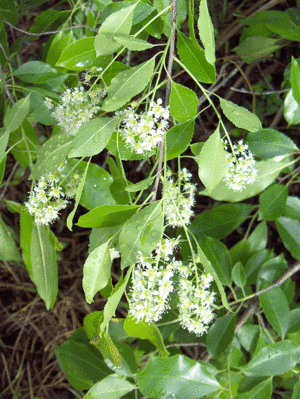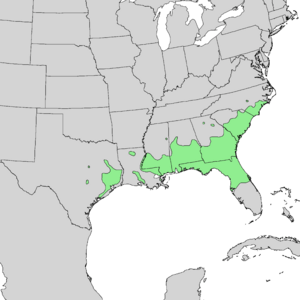Prunus caroliniana facts for kids
Quick facts for kids Prunus caroliniana |
|
|---|---|
 |
|
| Conservation status | |
| Scientific classification | |
| Genus: |
Prunus
|
| Species: |
caroliniana
|
 |
|
| Natural range of Prunus caroliniana | |
| Synonyms | |
|
|
Prunus caroliniana, known as the Carolina laurelcherry, Carolina cherry laurel, cherry laurel, or Carolina cherry, is a small evergreen flowering tree native to the lowlands of Southeastern United States, from North Carolina south to Florida and westward to central Texas. The species has also escaped into the wild in a few places in California.
Prunus caroliniana is not to be confused with its European relative Prunus laurocerasus, which is also called Cherry Laurel, though mainly known as English Laurel in the U.S.
Description
Prunus caroliniana is a small to medium-sized evergreen tree which grows to about 5–13 meters (16–43 ft) tall, with a spread of about 6–9 meters (20–30 ft). The leaves are dark green, alternate, shiny, leathery, elliptic to oblanceolate, 5–12 cm (2–4.5 in) long, usually with an entire (smooth) margin, but occasionally serrulate (having subtle serrations), and with cuneate bases. Reproductively mature trees have entire margins, whereas immature ones often have subtle serrations. The twigs are red to grayish brown, slender, and glabrous.
Fragrant white to cream-colored flowers are produced in racemes (stalked bunches) 5–8 cm (2–3 in) long in the late winter to early spring. The fruits are tiny black cherries about 1 cm (0.5 in) in diameter, which persist through winter and are primarily consumed by birds (February–April).
Characteristics
The leaves and branches contain high amounts of cyanogenic glycosides that break down into hydrogen cyanide when damaged, making it a potential toxic hazard to grazing livestock and children. Due to this, it is considered highly deer-resistant. When crushed, its leaves and green twigs emit a fragrance described as resembling maraschino cherries or almond extract.
Wildlife
Host plant for coral hairstreak, eastern tiger swallowtail, red-spotted purple, spring azures, summer azures, and viceroy butterflies where adult butterflies nectar from the spring flowers while the fruits are eaten by songbirds, wild turkeys, quail, raccoons, foxes, and small mammals.
Cultivation
Prunus caroliniana has long been an ornamental tree and landscape hedge shrub in gardens in many parts of the Atlantic states of the United States. The tree is considered hardy in USDA zones 7B through 10A. It is often used in areas where a tough broadleaved evergreen tree is needed of modest size. It prefers full sun and well-drained, acidic soil, often developing chlorosis if grown in overly alkaline soil. It is known to grow to elevations of 152 m (500 ft).
Cultivars
Cultivated varieties include:
- Prunus caroliniana 'Compacta' grows to about half the usual height and width of the species.
- Prunus caroliniana 'Cherry Ruffles' has wavy/ruffled leaf margins.


